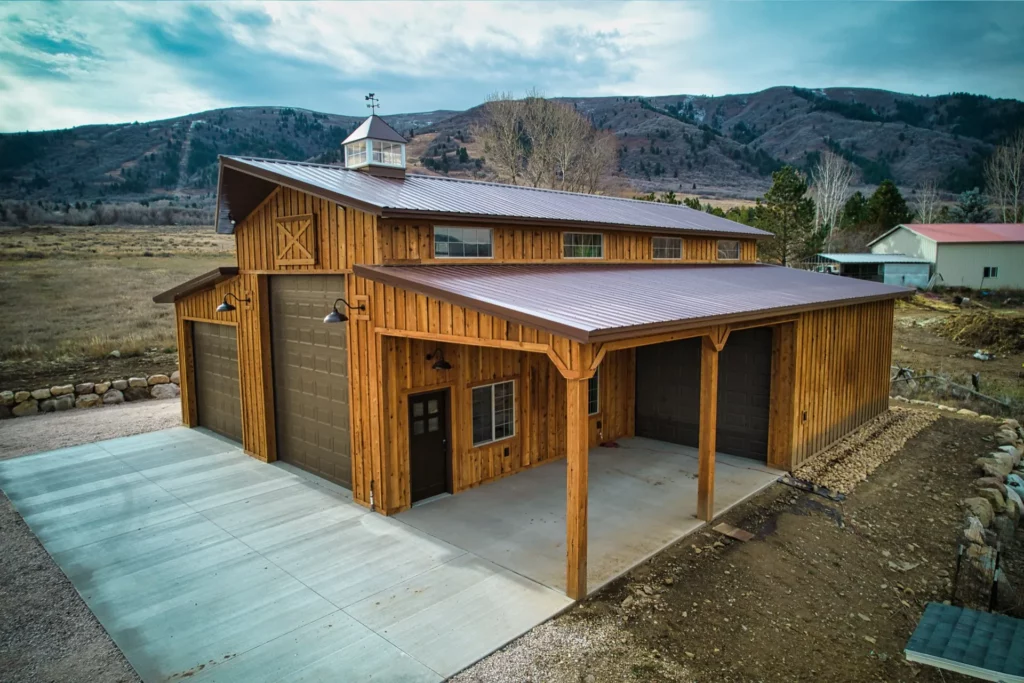Building a pole barn requires careful consideration, especially when it comes to the size of the posts.
These posts are the backbone of your structure, supporting the entire building and ensuring stability.
In this guide, we’ll explain how to determine the right size posts for your pole barn, the materials to use, and how to ensure your posts provide proper support. If you’re asking yourself, “is 40×40 pole barn is right?”—understanding post size and material is a great place to start.
What size post for a pole barn?
The size of the post for a pole barn depends on the barn’s dimensions and load requirements. Typically, 6×6 or 8×8 posts are used, but larger barns may need stronger posts for additional support.
Key Takeaways
- The size of the posts you choose will depend on the size of the pole barn, the intended use, and the weight the posts will support.
- Common post sizes for residential pole barns range from 4×4 inches to 6×6 inches, with larger sizes used for commercial structures.
- The depth and material of the posts are also essential considerations when building a stable pole barn.
The Importance of Choosing the Right Post Size

The posts in a pole barn are crucial for providing structural integrity. They hold up the entire frame and help resist the forces of wind, rain, snow, and even seismic activity in some areas.
The right size of post will ensure that your structure remChoosing the right size of post is key to keeping your structure solid and stable. It helps prevent sagging or even collapse. Along with learning how to square a pole barn, this step ensures everything stays strong and properly aligned from the start.ains solid and stable, preventing sagging or potential collapse.
To ensure the success of your pole barn project, it’s important to understand the weight-bearing capacity of your posts and how they interact with the other structural components.
Choosing the correct size post can also influence the overall cost and longevity of your pole barn.
What Are the Factors That Affect Post Size?
The size of the posts required for your pole barn will depend on several factors. Whether you’re working with custom blueprints or standard 24×36 pole barn plans, each factor must be considered carefully to ensure your structure is both functional and safe.
If you’re considering options like affordable metal pole barn kits, it’s essential to understand how post size impacts the overall stability, especially for specific dimensions such as a 24×32 pole barn kit. Proper planning will help you build a reliable structure that meets your needs without exceeding your budget.
If you’re considering options like affordable metal pole barn kits, it’s essential to understand how post size impacts the overall stability, especially for specific dimensions such as a 24×32 pole barn kit. Proper planning will help you build a reliable structure that meets your needs without exceeding your budget.
Let’s take a closer look at these factors:
The Size of the Pole Barn
The larger the pole barn, the larger the posts will need to be.
For example, a small barn that is 24×24 feet may only require 4×6 posts, while a larger structure, such as a 40×60-foot barn, will likely require 6×6 posts.
A mid-sized option like a 24×40 pole barn typically falls somewhere in between, often requiring careful planning to determine the appropriate post size based on design and load needs.
Larger barns, such as those with a 60×80 pole barn size, require more support due to the increased weight of the building materials and potential loads.
Small Barns (Under 30×30 feet): Typically, 4×6 or 6×6 posts will work well for smaller structures.
Medium Barns (30×40 to 40×60 feet): Larger posts, such as 6×6 or 8×8, may be necessary to support the increased size.
Large Barns (Over 60 feet long): Larger posts (e.g., 8×8 or more) are often required for commercial structures, such as a 60×120 pole barn, that experience higher loads.
Weight of the Structure
The materials used for the construction of the pole barn will affect the size of the posts.
A barn with a heavy roof, like metal roofing or one packed with insulation, needs larger posts to handle the extra weight. The same applies to barns that house heavy equipment or livestock, so it’s smart to find out how far apart pole barn posts go before planning your build.
Lightweight Structures: If your pole barn will primarily be used for storage or light farming activities, you may not need to invest in larger posts.
Heavy Duty Structures: If the pole barn will house large machinery, storage, or be used for agricultural purposes, you will need larger posts that can handle the load. In such cases, heavy 36×48 pole barn plans are an ideal choice, offering the structural strength and space needed for demanding uses.
Soil Conditions
The soil conditions of your property will affect the depth and size of the posts.
In areas with loose or sandy soil, larger posts are needed to ensure that the pole barn remains stable and does not shift over time.
In more compact and dense soils, such as clay or rocky areas, smaller posts may suffice, but they still need to be installed at the correct depth. If you’re wondering how deep to bury pole barn posts, the answer often depends on soil type and post size to ensure structural stability.
Loose Soil: Larger posts and deeper installation are necessary to prevent shifting and ensure stability.
Dense Soil: Posts may be slightly smaller, but they still need to be strong enough to support the structure.
Climate and Environmental Factors
When building a structure in regions prone to heavy snow or strong winds, it’s important to factor in these environmental elements when selecting your post size—especially for a small barn that is 24×24 feet, where structural stability is key.
The wind and snow load will put additional pressure on the structure, so it’s important to choose posts that can handle these forces.
Windy Areas: In places with strong winds, such as coastal regions or open plains, larger posts may be necessary for better wind resistance.
Snowy Regions: In areas with heavy snowfall, stronger posts will be needed to support the additional weight of the snow accumulation.
Recommended Post Sizes for Different Types of Pole Barns

Now that we’ve covered the key factors that affect post size, let’s dive into some general recommendations for different types of pole barns.
Residential Pole Barns
For a residential pole barn, such as a shed or garage, the size of the posts can typically range from 4×4 to 6×6 inches, depending on the barn’s size and the materials used. If you’re planning a project like this, following a detailed Pole Barn Garage Construction Guide can help ensure you choose the right post size, spacing, and materials to create a durable and long-lasting structure.
For smaller buildings, a 4×4 post can provide sufficient support, but for larger buildings or those in areas with higher snow or wind loads, 6×6 posts may be necessary.
Post Size for Smaller Residential Barns: 4×4 or 6×6 posts.
Post Size for Larger Residential Barns: 6×6 or 8×8 posts.
Commercial and Agricultural Pole Barns
Commercial or agricultural pole barns require larger posts due to their increased size and the need to support heavier equipment, livestock, or large storage areas. When deciding what size post for pole barn to use, it’s important to consider the barn’s dimensions and intended use. For smaller residential barns, 4×4 or 6×6 posts may suffice, while larger commercial or agricultural barns may require 8×8 or larger posts for added support.
For these structures, 6×6 posts are a minimum, but 8×8 or even larger posts may be necessary for very large buildings.
Post Size for Medium Agricultural Barns: 6×6 or 8×8 posts.
Post Size for Large Agricultural or Commercial Barns: 8×8 or larger posts.
Pole Barns in Areas with Harsh Weather
In areas that experience extreme weather conditions, such as heavy snow or high winds, it’s important to choose larger posts to provide extra stability.
In these regions, 8×8 or even 10×10 posts might be required for larger barns.
Post Size for Harsh Weather Areas: 8×8 or 10×10 posts.
How to Choose the Right Post Material
The material of the posts you choose will also impact their strength, durability, and cost. Below are some common materials used for pole barn posts:
Wooden Posts
Wood is a traditional material for pole barn posts and is often used for residential and small commercial buildings.
Wooden posts are a budget-friendly and versatile option, commonly chosen for their ease of use and variety of sizes. However, in moisture-prone environments, they can be vulnerable to rot and decay. See why our 40×60 pole barn kit is a top choice for those seeking durability and performance beyond standard wood posts.
However, they can be susceptible to rot and decay, especially in areas with high moisture. To protect your structure, it’s essential to follow tips to keep pole barn posts from rotting, such as using pressure-treated wood, ensuring proper drainage around the posts, and applying protective coatings to minimize moisture exposure.
Best for: Smaller residential barns or sheds.
Steel Posts
Steel posts are durable, strong, and resistant to rot, making them a great choice for pole barns in areas with high moisture or pests.
Steel posts can be more expensive upfront, but their longevity often makes them a better investment in the long run.
Best for: Agricultural and commercial barns or buildings in damp conditions.
Concrete Posts
Concrete posts are incredibly strong and durable, making them ideal for heavy-duty pole barns.
They are resistant to rot and can withstand extreme weather conditions. However, they can be difficult to install and are more expensive than wooden or steel posts.
Best for: Large commercial barns and barns in areas with extreme weather.
When to Call a Professional for Pole Barn Construction

While you can handle some aspects of building a pole barn yourself, such as clearing the area and preparing the site, it’s often best to consult with a professional when it comes to post installation.
Professionals have the experience and equipment necessary to ensure the posts are properly set in the ground, level, and aligned for maximum stability.
If you’re unsure about which post size to choose or if you’re dealing with difficult soil or environmental conditions, it’s always a good idea to get advice from an expert—especially when planning a large structure like a 40×80 pole barn—to avoid costly mistakes.
Frequently Asked Questions
1. How deep should the posts be for a pole barn?
The depth of the posts depends on the type of soil and the size of the barn, but they should generally be installed 3 to 4 feet deep for adequate stability.
2. Can I use pressure-treated wood for pole barn posts?
Yes, pressure-treated wood is commonly used for pole barn posts as it helps protect against rot and insect damage.
3. How do I know if I need larger posts for my pole barn?
If your barn is large, located in an area with extreme weather, or will house heavy equipment, larger posts (such as 6×6 or 8×8) may be necessary for proper support.
Conclusion
Choosing the right post size for your pole barn is essential for ensuring the stability and durability of the structure.
By weighing factors like barn size, soil, and local climate, you’ll know exactly what your project requires. If you’re unsure, researching how many support posts for 30×40 pole barn designs can help guide your decision.
Whether you opt for wooden, steel, or concrete posts, always make sure they are installed properly to ensure a safe and functional pole barn.

